Made up your mind about growing hydroponics, but are confused over what nutrients they need and which ones should you buy?
Well, worry not because by going through this guide, you will be able to decide the best hydroponic nutrients for vegetables that will make your plant grow exponentially.
Normally, plants get their nutrients from the dissolved minerals in the soil. However, in hydroponic since the soil is not involved, we ourselves have to provide the nutrients.
With so many brands and types in the market, the growers get confused over which one to buy.
To solve this problem, we have written this extensive guide to help you understand the factors that you should look for while buying hydroponic nutrients. We have also added 7 tried and tested nutrients to help you get the best from the shelf.
Best Hydroponic Nutrients for vegetables
Important Things to Understand Hydroponic Nutrition
There are a few things that you must know before venturing into hydroponic nutrition. Here are those
How To Find Growing Medium Nutrient Contents?
The nutrition contents of a growing medium are found by testing the EC and pH values.
These values give the estimate of salinity and acidity of the soil, allowing the grower to evaluate the fertility of the soil.
Before adding the nutrients to the growing medium, one thing that you must know is the already-held nutrition content of the soil.
This is necessary to ensure that nutrients do not exceed their limit, causing toxicity to the plant.
Here are the ways the salinity and acidity of the soil is found.
- Electrical conductivity (EC) denotes the number of dissolved ions in the water. In other words, it shows the amount of dissolved salts in the growing medium, also called salinity.
The current moves from negative terminal to positive terminal inside the battery, and gives different values with different solute concentrations. This is because of the ions that carry the charge when current is applied to the solution.
Hence, the greater the ions in the water, the greater the EC, and vice versa. The average EC value for most plants is 0.8 – 2.8, but some plants can have lower or greater than this average. - pH is a scale to express from 1-14 to express the acidity or basicity of any substance. Different plants have different pH affinities. Generally, plants prefer slightly acidic soil of pH 5.5 – 6.2.
There is no need to maintain highly specific soil for different plants unless you are doing some research work in a lab. So, for us, slightly acidic soil will work, which we can ensure by a pH kit that you can find at any lab store.
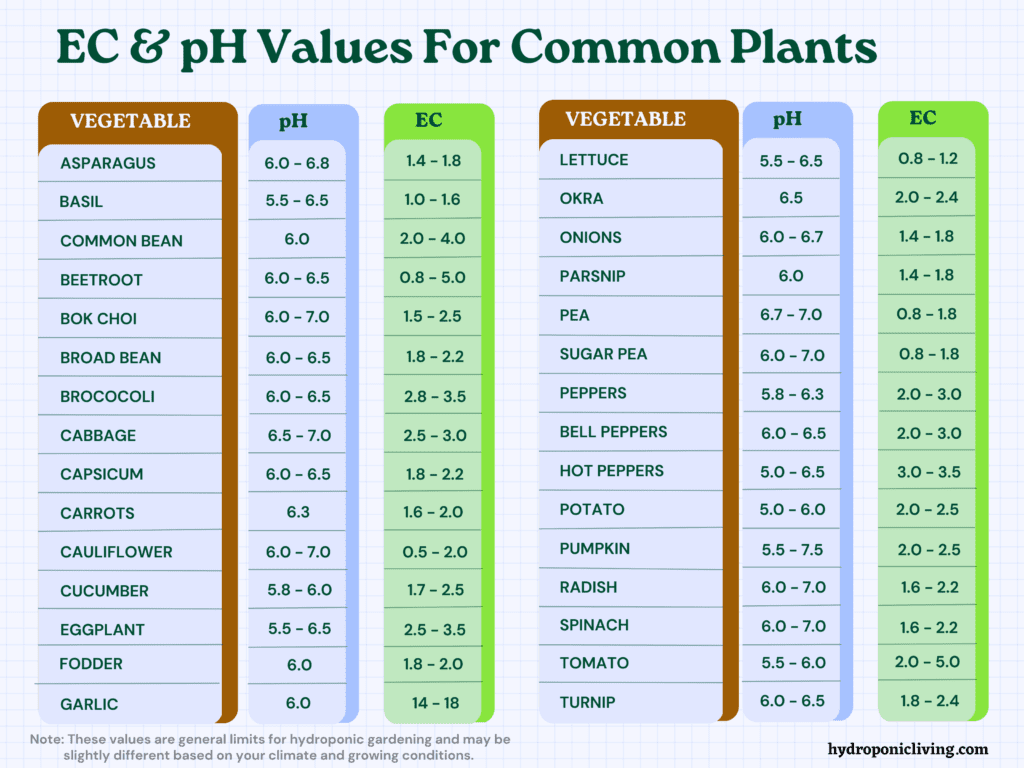
Types of Plant Nutrients
Just as the human body needs different nutrients to function properly, so does the plant body.
In fact, plant nutrients are much categorized to make it easier for us to account for and provide them. There are three basic types of nutrients that plants need
Macro Nutrients
Nitrogen, phosphorus, and potassium, simply denoted as NPK, are the macronutrients. Plants require them in abundance and hence are the most important nutrients for them. The absence of any one will result in retarded or stunted growth.
- Nitrogen is involved in the formation of the color-imparting pigment, chlorophyll. This pigment gives green color to the leaves. Nitrogen is also the main constituent of a number of important biomolecules such as proteins, nucleic acids, and nucleotides. Hence, the lack of nitrogen affects the formation and processing of all these vital molecules necessary for life.
- Phosphorus serves as the energy storing in the phosphate linkages of ATP, the cell’s energy currency. This energy is then used to drive all the bioprocesses necessary for life.
- Potassium is important in regulating several enzymatic reactions, as this is also involved in Sodium Potassium pumps. These pumps regulate the amount of absorption and removal of Carbon dioxide from the leaves, hence dictating the rate of photosynthesis.
Micro Nutrients
These nutrients, although required in lesser amounts as compared to NPK, are still necessary for the normal growth of plants.
There are 11 micronutrients which are nickel, calcium, copper, manganese, iron, molybdenum, chloride, zinc, and boron.
Though the lack of a few micronutrients might not pose any serious risk to plant life, but that plant will surely lack certain characteristics.
Each nutrient has specific properties that it imparts to the plant, which enables it to produce the best harvest.
Trace Nutrients
These nutrients are required by plants in negligible amounts. Oftentimes, the seed of the plant contains enough of these nutrients to be plentiful for the whole lifetime of the plant.
However, it still needs to load its seeds with that nutrient. Otherwise, the next-generation plants would have certain complications due to the absence of certain trace nutrients.
Types of Hydroponic Nutrients
Hydroponic nutrients are classified on basis of their origin and form. On the basis of origin, they are either organic or synthetic. While on the basis of form, they can be solid form or liquid form. Here is how these forms differ from each other
Organic vs Synthetic Hydroponic Nutrients
Organic nutrients are what comes from nature, and then return to nature, only to come back again as fruits, and the cycle repeats.
Kitchen waste compost, manure, and rotting leaves are all examples of organic nutrients for plants.
However, to complete this cycle, decaying microorganisms need to decompose the organic waste into a form that is absorbed by the plant.
This setup is kind of messy and does not suit the hydroponic culture technique, which is rather hygienic and clean practice.
Synthetic nutrients on the other hand are not made by nature but are processed in the plants keeping in mind the delicate needs of plants and required nutritious proportions. These are already in absorbable form by hydroponics.
There are a lot of different brands and types of synthetic nutrients, to meet the needs of different plants.
They contain the right proportions of different nutrients that trigger desired outcomes from the plant. You can buy the right synthetic nutrient if you understand the needs of your plants, and what you desire to attain from it.
Liquid vs Solid Hydroponic Nutrients
Liquid nutrients for hydroponic plants are generally more soluble and readily absorbable for plants, due to the fact that the growing medium is also liquid. They are also easy to apply; just pour the right amount into the growing medium.
It is due to these user-friendly characteristics that they are suggested to beginners before they consider solid-form nutrients.
Solid-form nutrients generally have a longer shelf life, but are not readily available to plants.
Plants cannot take them up as easily as they take liquid form. Moreover, the solid form is more soil for soil rather than for water.
However, most solid form nutrients are water-soluble and are mixed with water before being given to the plant.
Why Synthetic Hydroponic Nutrients Are Good Option
To understand why synthetic nutrients are good option for your hydroponics, first you need to understand why hydroponics need nutrients in the first place. Why can’t we grow plants any other way?
Well, you might be able to grow your “plants” without adding the nutrients, but not the hydroponic plants. Here’s why
Why do hydroponics need nutrients?
Just as we need food for our growth and development, plants need nutrients for maturation, vegetation, and fruiting.
Normally plants take it from the soil which contains dissolved minerals, salts, and nutrients.
But since hydroponics have water as a growing medium instead of soil, we ourselves need to provide them with the necessary nutrients.
The other option, the organic ones, use biological reactions involving the living microbes, which produce an unpleasant odor that is not suitable for hydroponic systems, which are well-known for their cleanliness.
Growing Non-native plants- Different plant species have different natural habitats, body types, and fruiting bodies, and so do their nutrient needs. These factors limit their ability to grow in non-native environments.
However, through synthetic nutrients, we can replicate the growing media similar to the local ones of any plant.
In this way, we can grow any plant anywhere, and any time of the year.
More control over the plants– Plants absorb these nutrients as it does with natural ones, and the results are pretty much similar.
One thing that is different is the level of control. In hydroponics, we have complete control over the type, concentration, uptake, and relative proportion of the nutrients available for the plant.
In this way, we can get desired outcomes, making it a preferred choice for hobbyists and commercial growers.
7 Best Hydroponic Nutrients For Vegetables
MasterBlend 4-18-38 Tomato & Vegetable Fertilizer
With a relatively high proportion of phosphorus and potassium, MasterBlend 4-18-38 Tomato & Vegetable Fertilizer gives plants all the necessary nutrients to produce as many fruiting vegetables like tomatoes as nutritiously possible without risking the quality.
This is a solid-form nutrient fertilizer that needs to be dissolved in water before it becomes available to the plant. Moreover, plants cannot take this up directly. It is first mixed up with Epsom salt (magnesium sulfate) and calcium nitrate. After the mixing, now the nutrients are present in an absorbable form.

How to use:
To prepare 5 gallons, add 2 tablespoons of formula to water and stir until dissolved. Then add 2 tablespoons of magnesium sulfate and again stir until dissolved. Finally, add 2 tsp of calcium nitrate and stir the whole mixture. Remember the 2-2-2 formula; 2 tsp of all compounds.
You can increase or decrease the pH of the mixture as required by your plant. You can check out this chart to know the optimum pH value for your plant.
Microbe Life Hydroponics Yield Enhancer
Even after adding the nutrients, the plant is not showing good growth. Then the problem might not be in nutrients but in the plant’s ability to uptake that nutrients. The solution to this problem is Microbe Life Hydroponics Yield Enhancer.
This yield enhancer acts on the plant, instead of the growing medium, and enhances its ability to absorb nutrients more efficiently. In hydroponics, the natural survival of the fittest rule does not apply since the conditions are artificially created. So, they rely dominantly on nutrient absorption from the growing medium to grow and thrive.
They contain friendly bacteria and fungi, helpful chemicals, and other environmental friendly compounds that all aid plants in growing better.
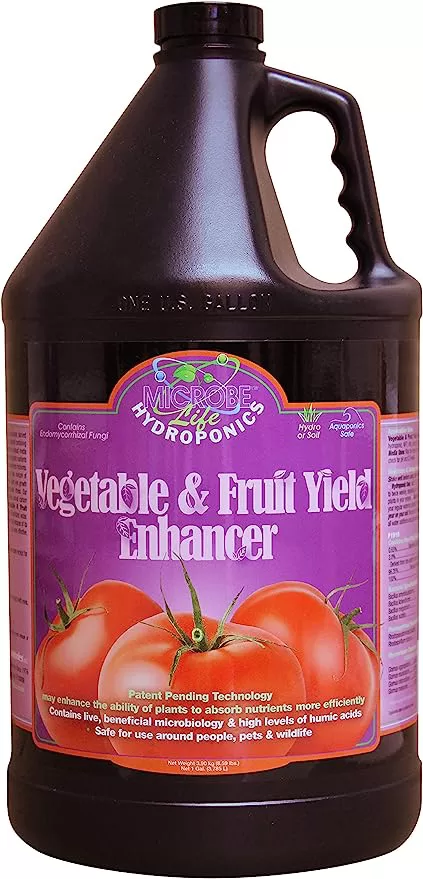
How to use:
For first-time use, add 2 ounces of enhancer in 5 gallons of water and then add it as a growing medium for hydroponic. After that, add 1 ounce every week, or 2 ounces every 2 week in 5 gallons of growing medium.
AeroGarden Liquid Nutrients
This nutrient solution is your plant’s companion right from seed germination to fruiting. AeroGarden Liquid Nutrients helps in seed germination, growth and development, and then flowering aka fruiting.
This is ideal for growers who do not want to keep a record of different nutrients and fertilizers. Since this is a one-part nutrient solution, you do not need to mix or accompany it with any other nutrient from the market.
However, it works more efficiently with the AeroGarden grow system, which can remind you to add nutrients to the plant whenever needed. But if you remember to add the liquid nutrient to the growing medium every two weeks, then no need of reminding systems either.
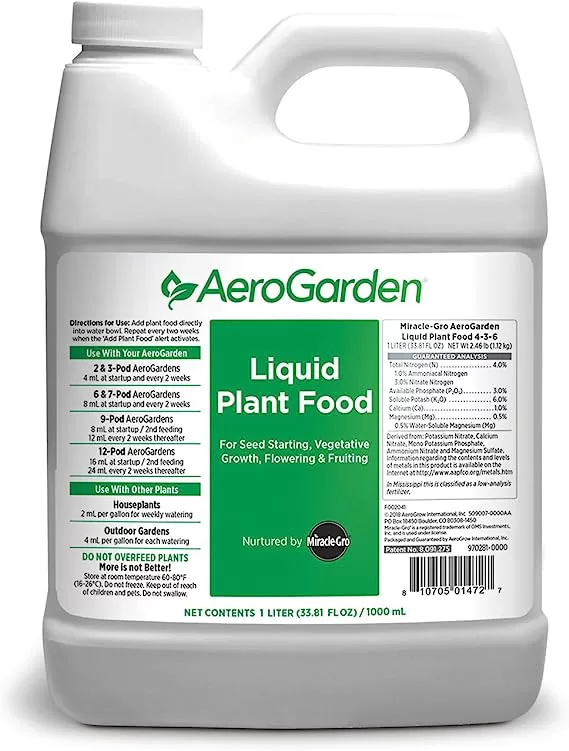
How to use:
For hydroponics and other indoor plants, use 2 mL of the liquid nutrient in 1 gallon of water, and give it to the plant every week.
General Hydroponics Flora Grow, Bloom, Micro Combo Fertilizer Set
This three-part nutrient system by General Hydroponics caters to the needs of growers that aim to solve the specific problems of their problems. The three fertilizers included in this set all target different phases of plants to bring out different outputs.
FloraMicro, rich in nitrogen concentration, is aimed to provide chlorophyll enrichment to the plant. It causes leaf growth, enhances vegetation, and provides the other micronutrients necessary for the growth and development of the hydroponic plant.
The second nutrient solution, Florabloom, is rich in phosphorus and potassium, both of which focus on speeding and enhancing the flowering and fruiting of hydroponics. This product is to be used when the plant body has fully developed and is on the onset of producing flowers. Besides the rate of fruiting, it also increases the number.
FloraGro contains more or less all three macronutrients NPK. Hence, its overall usage is for the overall growth of stems, leaves, and flowers. It also contains all the other necessary nutrients that ensure that the plant is not deficient in any usable nutrient, and grows as a well-developed, healthy, fruiting body.
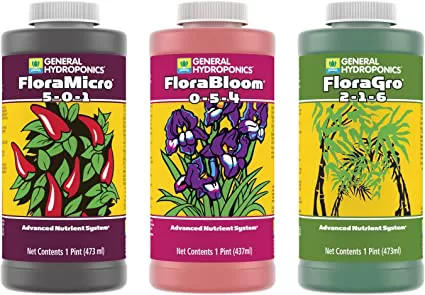
When used correctly at the right times during different growth phases of plants, they work hand in hand to bring the best results in hydroponic growth, fulfilling all its nutrient growth in all phases.
How to use:
When the plant is seedling, mix 2 mL of FloraGro in 1 gallon of water. Then add 2 mL of FloraMicro and then 2 mL of FloraBloom. Adding them all together can cause nutrient lock-out. Then water the mixture to the plant.
The concentrations would likely increase as the plant grows and demands more nutrients. For that, please refer to this chart.
Blue Planet Nutrients | Calcium Magnesium Iron for Vegetables
Even after having all the macronutrients, plants do not show normal growth and end up with problems like Blossom End Rot & Upward Leaf Curl. These are not diseases and are easily treatable with the induction of necessary micronutrients like Ca, Mg, and Fe. Blue Planet Nutrients’ Calcium Magnesium Iron for Vegetables does exactly that.
It helps the plant perform basic, yet vital functions like mineral uptake, transport, and blooming normally. It is very simple to use; mix it with water and then add it to the growing media in the required amount.
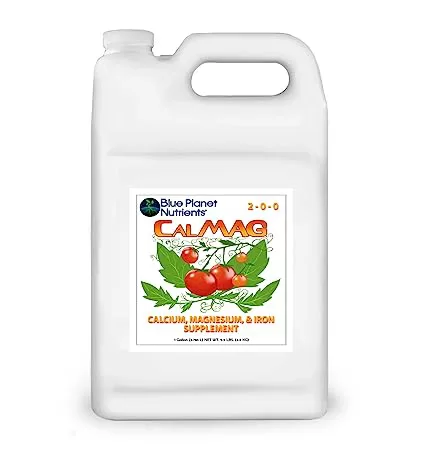
How to use:
Stir the liquid well before pouring 3 – 5 mL into 1 gallon of water. Then water this to the plant every week. Adjust the pH of the mixture as per required by the plant.
Botanicare HGC732110 Cal-Mag Plus
This nutrient supplement by Botanicare complements the micronutrient deficiencies of the growth medium by enriching it with high concentrations of iron, calcium, and magnesium. Iron makes up the central most atom of the chlorophyll molecule, the absence of which can lead to the yellowing of leaves. Calcium fortifies the plant stem, and magnesium ensures healthy plant development.
Botanicare Cal-Mag Plus is used to make up for the deficiency of these three elements in the soil. This acts more like a supplement to already added nutrients than a complete solution itself.
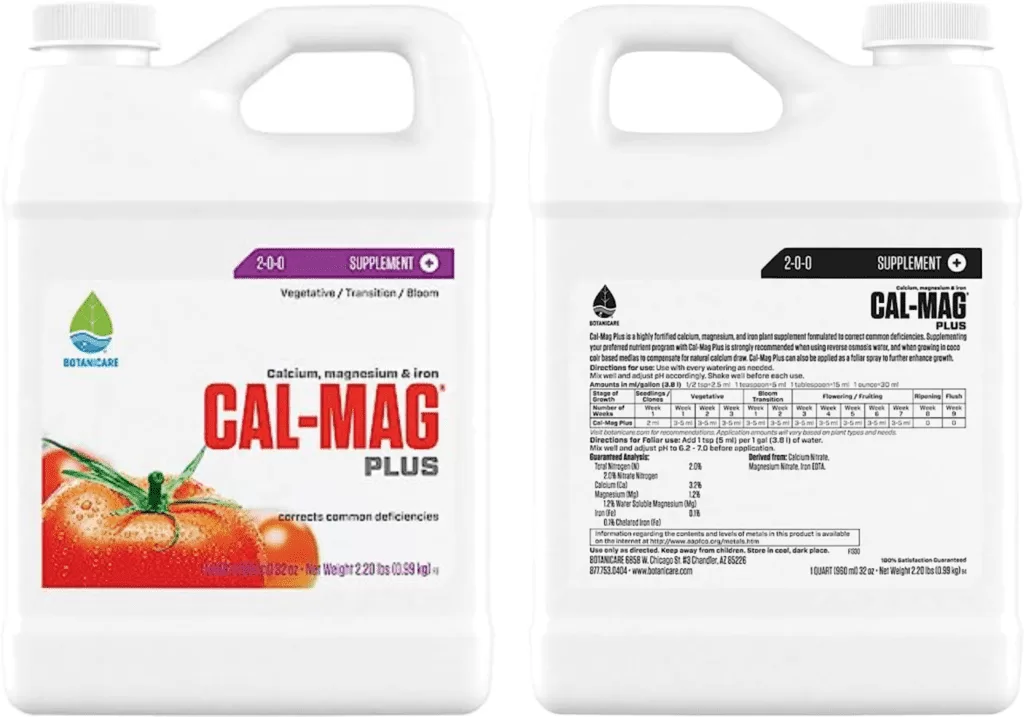
How to use:
To make up the deficiencies immediately, add 1 tablespoon of Cal-Mag Plus
In 1 gallon of water. Water this mixture to the plant, while keeping its pH within limits of 6.2 – 7.0
FoxFarm Big Bloom, Grow Big & Tiger Bloom Hydroponic Plant Food
These synthetic nutrient fertilizers, but with completely organic ingredients. These organic components give the natural strength and minerals needed by hydroponics to grow, develop and bloom substantially.
The high-quality organic ingredients include earthworm casting, which is full of nitrogen from amino acids, bat guano, Norwegian kelp, rich in manganese and zinc, and rock phosphate to replenish the phosphate of the soil.
The three nutrients are to be used during different growth phases of the hydroponic. First, use Grow Big when the plant is seedling, until it becomes a healthy plant with a strong stem. Grow big contains high nitrogen concentration, aiding in growth and strong stem formation.
Then, use Tiger Bloom at the onset of the flowering phase, and continue until the fruits are ripe and harvested. It increases the rate of flowering and size of fruits. After the harvest, use Big Bloom to replenish all the used nutrients and wear and tear on the plant, like regrowth of roots, and healing of the nutrient transport systems.
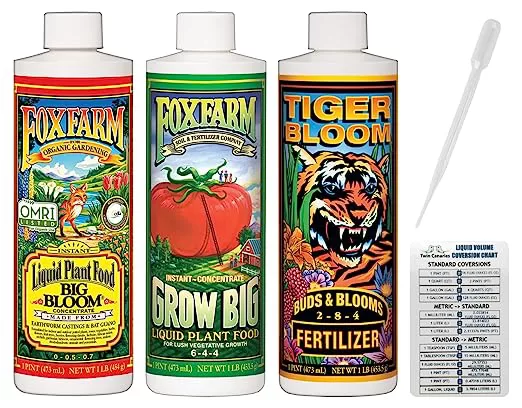
How to use:
Using the 2-2-2 formula. First, add 2 tablespoons of Tiger Bloom to 1 gallon of water. Add 2 tsp of Grow Big in it, and then add 2 tablespoons of Big Bloom. Start using it when the first flower appears and continue the usage till the harvest of last fruit.
Growers also use this as a spray. Use on both sides of the leaves for best results.
Pros:
The type of nutrients is as important to plants as the quality of diet is to us. Therefore, the choice of nutrients directly controls the health and yield of your plants. Now it wouldn’t be nice to deprive your plants of a healthy diet, or any diet at all, would it? Since you now know everything to be able to decide the best hydroponic nutrient for your vegetables, the only thing that remains to do is “buy”! So better get up and feed your plant now.

3 thoughts on “Best Hydroponic Nutrients For Vegetables: A Definitive Guide”